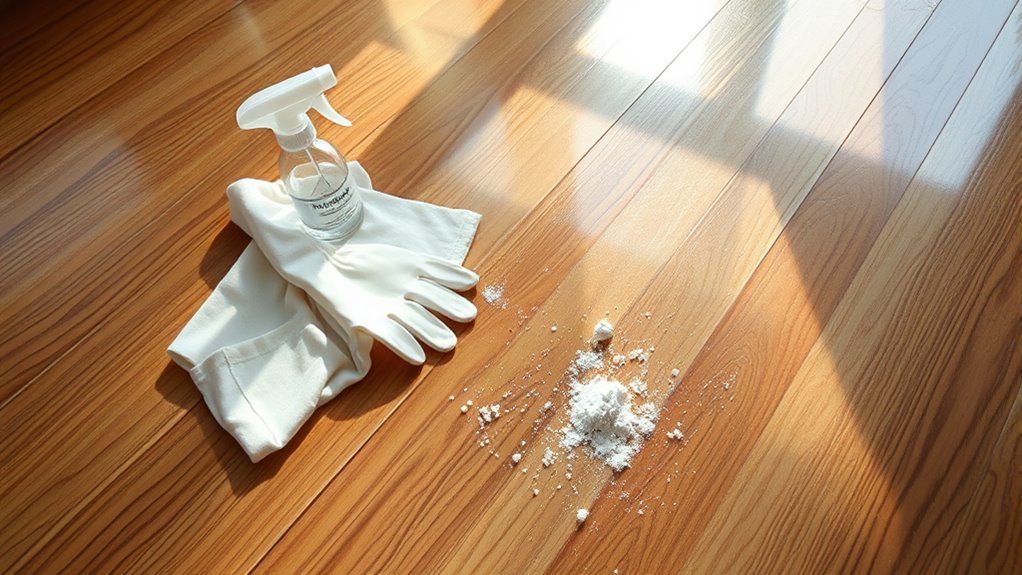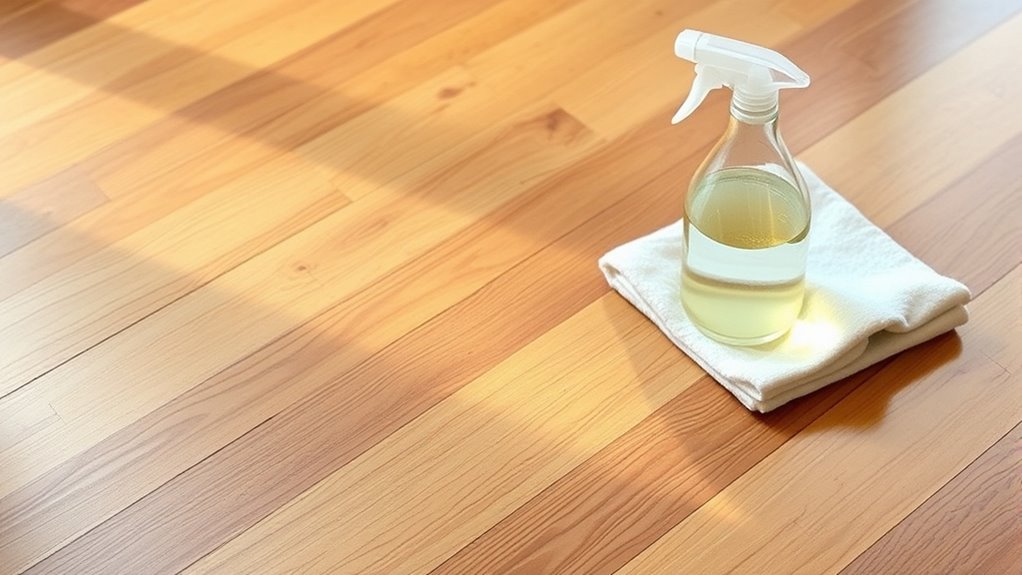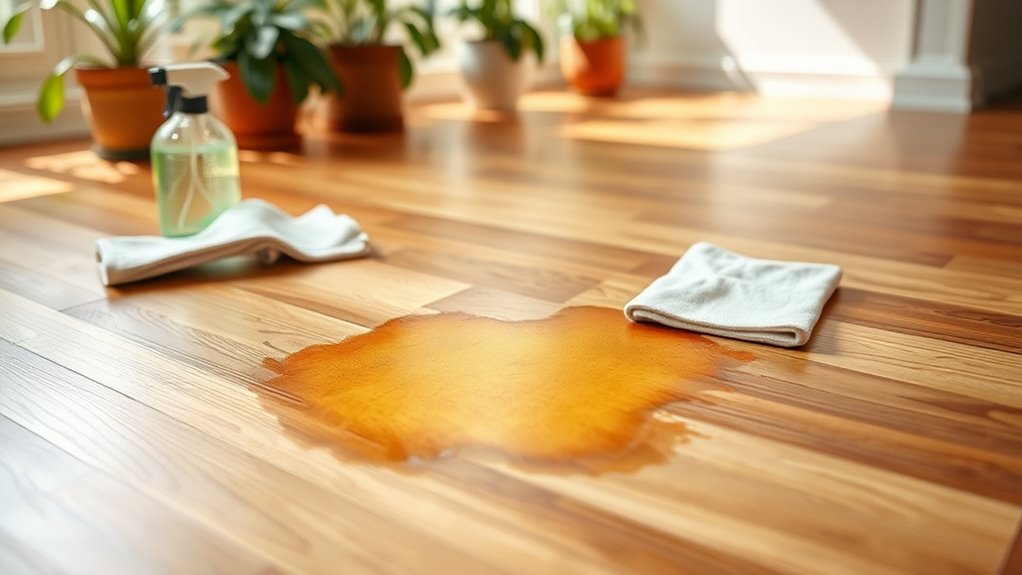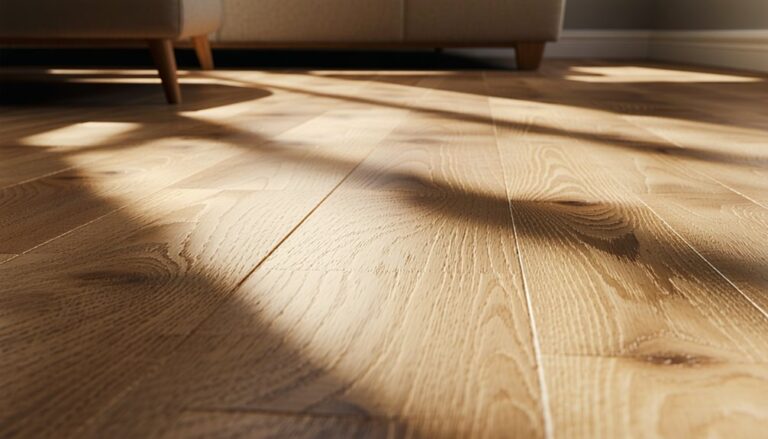To remove urine stains from your hardwood floor, first blot the spill promptly with a clean cloth. Identify your floor’s finish to avoid damage. Use a mix of two parts water and one part vinegar to gently clean the spot, then sprinkle baking soda to neutralize odors. For stubborn stains, apply 3% hydrogen peroxide carefully. If stains penetrate deeply, sanding and refinishing might be necessary. Keep following for more detailed steps and prevention tips to protect your floors.
Identifying the Type of Hardwood Finish

Before you can effectively remove a urine stain from your hardwood vloer, you need to identify the type of finish on the wood. Hardwood finishes vary, and knowing your finish type helps you choose the right cleaning method without causing damage. Common finish types include polyurethane, shellac, varnish, and wax. Polyurethane finishes are durable and glossy, while shellac tends to be softer and more sensitive to moisture. Varnish offers a hard, protective coat, and wax finishes provide a natural, matte appearance but require gentle care. To identify your finish, test a small, hidden area with a damp cloth or a mild solvent like alcohol. Noting how the wood reacts will guide your approach, ensuring you maintain your floor’s integrity and enjoy the freedom of a spotless, undamaged surface.
Gathering Necessary Cleaning Supplies
Once you know your floor’s finish, you’ll need to gather the right cleaning supplies to tackle the urine stain effectively. Start with basic cleaning tools: a soft cloth or microfiber towel, a scrub brush with gentle bristles, and a bucket for mixing solutions. Choose a stain remover suitable for hardwood floors—avoid harsh chemicals that can damage the finish. Opt for enzyme-based cleaners designed to break down urine molecules without harming wood. Have white vinegar and water on hand as natural alternatives if preferred. Gloves will protect your hands during cleaning, and paper towels can help absorb excess moisture. By assembling these specific cleaning tools and a reliable stain remover, you’ll be prepared to address the stain thoroughly, preserving your floor’s integrity and maintaining your freedom to enjoy a spotless living space.
Immediate Steps to Take After a Urine Spill

When you notice a urine spill, start by blotting up as much liquid as possible to prevent it from soaking deeper into the wood. Next, apply a mild cleaner to the affected area to break down any residue without damaging the finish. Finally, make sure to dry the spot thoroughly to avoid moisture damage and lingering odors.
Blot Excess Urine
Start by quickly grabbing paper towels or a clean cloth to blot up as much urine as you can. Effective blotting techniques are essential here—press gently rather than rubbing, which can spread the urine and push it deeper into the wood grain. Use fresh towels as needed to maximize urine absorption, replacing saturated cloths promptly. Work systematically from the outer edges of the spill toward the center to avoid enlarging the affected area. The goal is to remove as much liquid as possible before it soaks into the hardwood, which helps minimize staining and odor later. Remember, swift and precise blotting sets the foundation for successful cleaning, preserving your floor’s natural beauty and giving you the freedom to tackle the next steps confidently.
Use Mild Cleaner
A few drops of a mild cleaner can make a significant difference in removing urine stains from your hardwood floor. Start by selecting mild cleaner options like diluted dish soap, white vinegar mixed with water, or a gentle hardwood floor cleaner. Avoid anything abrasive or heavily scented that could damage the wood finish. For cleaner application, dampen a soft cloth or sponge with your chosen solution—never pour it directly onto the floor. Gently rub the stained area in a circular motion to lift the urine without spreading it. This method preserves your floor’s integrity while effectively loosening the stain. Using mild cleaner options carefully guarantees you clear the mess without compromising your hardwood’s natural beauty and finish.
Dry Area Thoroughly
After gently cleaning the urine stain with a mild solution, you’ll want to dry the area thoroughly to prevent any lasting damage. Proper drying techniques are essential to control moisture and avoid warping or mold growth. Use absorbent cloths or paper towels to blot excess liquid immediately. Follow this with a fan or dehumidifier to speed up evaporation and maintain moisture control.
| Drying Technique | Doel |
|---|---|
| Blotting | Removes surface moisture |
| Using fan | Enhances air circulation |
| Luchtontvochtiger | Reduces ambient humidity |
| Avoid heat sources | Prevents floor damage |
Using a Vinegar and Water Solution for Cleaning

Two parts water mixed with one part vinegar creates an effective solution for removing urine stains from hardwood floors. This water solution leverages vinegar benefits, such as natural acidity, to break down urine residue without damaging your floor’s finish. Start by pouring the solution into a spray bottle for easy application. Spray the affected area generously and let it sit for 5–10 minutes to penetrate the stain. Next, gently scrub with a soft cloth or sponge, working in the direction of the wood grain. Avoid saturating the floor to prevent water damage. Finally, wipe the area dry with a clean towel to remove excess moisture. Using this method, you’ll clean effectively while preserving your hardwood floor’s integrity and enjoying a fresh, odor-free space.
Applying Baking Soda to Neutralize Odors
You’ll want to use baking soda because it effectively absorbs and neutralizes odors without damaging your hardwood floor. Simply sprinkle a generous layer over the affected area and let it sit for several hours or overnight. Afterward, vacuum or sweep it up to remove both the baking soda and trapped odors.
Baking Soda Benefits
Baking soda is a powerful and natural deodorizer that can effectively neutralize urine odors on hardwood floors. When you use baking soda, it works by absorbing moisture and breaking down the compounds causing the smell, ensuring thorough odor removal. This means you won’t just mask the odor—you’ll eliminate it. Baking soda’s gentle, non-toxic nature also protects your floor’s finish and provides a safe option for households with pets or children. Plus, it’s cost-effective and readily available, giving you freedom from expensive chemical cleaners. By relying on baking soda, you take control of a simple, eco-friendly solution that restores your hardwood’s freshness without compromising its integrity or your health. This makes baking soda an essential tool in your cleaning arsenal.
Toepassingstechnieken
Since baking soda is so effective at neutralizing urine odors, knowing how to apply it correctly will maximize its benefits. Proper application techniques guarantee the cleaning methods work efficiently without damaging your hardwood floor. First, thoroughly blot the stain with a clean cloth to remove excess moisture. Then, sprinkle a generous layer of baking soda directly over the affected area, covering it evenly. Finally, let the baking soda sit for several hours or overnight to absorb odors and moisture.
- Use a soft brush to gently spread the baking soda for better coverage
- Avoid saturating the floor with liquids before applying baking soda
- Vacuum or sweep up the residue completely after treatment
Odor Neutralization Process
Although it might seem simple, the odor neutralization process relies on the chemical properties of baking soda to effectively eliminate urine smells from hardwood floors. First, verify the area is dry before sprinkling a generous layer of baking soda over the stain. Baking soda acts as one of the best natural deodorizers, absorbing moisture and neutralizing acidic urine odors. Let it sit for several hours or overnight for maximum effect. Once absorbed, vacuum or sweep up the powder thoroughly. This method fits well within odor removal techniques that avoid harsh chemicals, giving you control and freedom to maintain your floors naturally. Using baking soda not only tackles the smell but also prevents lingering odors, helping you keep your hardwood floors fresh without compromising on safety or simplicity.
Treating Stubborn Stains With Hydrogen Peroxide
If you’ve tried basic cleaning methods without success, hydrogen peroxide can be a powerful option for treating stubborn urine stains on hardwood floors. Its effectiveness lies in its ability to break down organic compounds without damaging the wood finish when used properly. To maximize hydrogen peroxide efficiency in stain removal techniques, follow these steps:
- Test a small, hidden area first to verify no discoloration occurs.
- Apply 3% hydrogen peroxide directly to the stain using a clean cloth or spray bottle.
- Let it sit for 5-10 minutes, then gently blot with a damp cloth to lift the stain.
Repeat if necessary, but avoid excessive soaking to protect the wood. This method offers a balance between strong stain removal and preserving your floor’s natural beauty.
Sanding and Refinishing Deep Stains
When urine stains have penetrated deeply into your hardwood floor, sanding and refinishing is often the most effective solution. Start by selecting the right sanding techniques: use a drum sander for large areas and an edge sander for corners. Begin with coarse-grit sandpaper to remove the stained surface, then progressively switch to finer grits for a smooth finish. After sanding, clean the dust thoroughly before moving to refinishing options. You can choose from oil-based or water-based polyurethane, each offering durability and a different sheen. Apply multiple thin coats, allowing proper drying time between each. This method not only removes deep stains but also renews your floor’s appearance, giving you the freedom to restore your space to its original beauty with precision and confidence.
Preventative Measures to Avoid Future Urine Stains
After restoring your hardwood floor by sanding and refinishing, the next step is to protect your investment by preventing future urine stains. Establishing a proactive approach lets you enjoy your space freely without worry. Focus on early urine detection and consistent upkeep. Here’s how:
- Use pet urine detection tools or blacklight to spot stains early, preventing deep damage.
- Implement a strict cleaning schedule, addressing spills immediately with appropriate hardwood-friendly cleaners.
- Train pets or designate bathroom areas to minimize accidents on wood surfaces.




